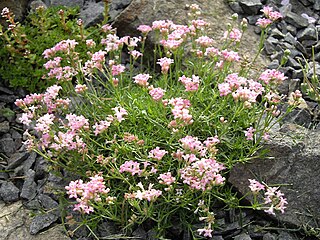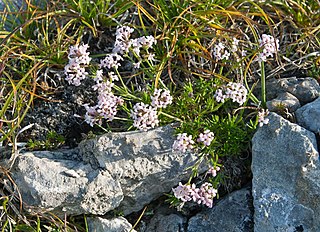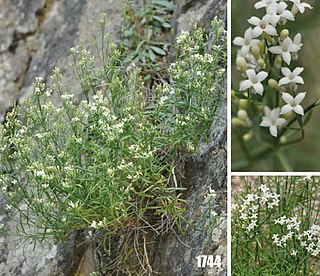
Bistorta vivipara is a perennial herbaceous flowering plant in the knotweed and buckwheat family Polygonaceae, commonly known as alpine bistort. Scientific synonyms include Bistorta vivipara and Polygonum viviparum. It is common all over the high Arctic through Europe, North America, incl. Greenland, and temperate and tropical Asia. Its range stretches further south in high mountainous areas such as the Alps, Carpathians, Pyrenees, Caucasus, Alaska and the Tibetan Plateau.

Anemone hepatica, the common hepatica, liverwort, liverleaf, kidneywort, or pennywort, is a species of flowering plant in the buttercup family Ranunculaceae, native to woodland in temperate regions of the Northern Hemisphere. This herbaceous perennial grows from a rhizome.

Cortusa is a formerly recognized genus in the family Primulaceae. It is now regarded as a synonym of the genus Primula. It consisted of about 19 species of delicate, hardy, alpine perennials. The genus was named by the herbalist Matthiolus after his friend Cortusus, professor of botany at Padua, who discovered the plant originally called Cortusa matthioli (now Primula matthioli. The plants are flowering herbaceous perennials native to the mountains of southern and eastern Europe, including the Alps and the Carpathians, with some species native to China. Most of the species are small spring bloomers for shade and rock garden. These low-growing and rather handsome little plants have clumps of downy, light green, heart-shaped leaves with serrated edges. In late spring, small loose umbel of delicate bell-shaped to lily-liked flowers born terminally on drooping spikes arise from the base, some 6-8in high. Flowers are magenta, pink, white and yellow. They are dormant in some months, and as spring begins, stems and leaves quickly start to reproduce.

Castilleja septentrionalis is a species of Indian paintbrush known by several common names, including northern paintbrush, sulfur paintbrush, and pale painted cup. There is taxonomic disagreement as to if it is one species widely distributed in mountain and alpine environments of North America or if there is a second species, Castilleja sulphurea, in the Rocky Mountains.

Leopoldia is a genus of bulbous perennial plants in the family Asparagaceae, subfamily Scilloideae. The genus is widespread around the Mediterranean region and neighboring lands, from the Canary Islands to Iran.

Cynanchica, commonly known as woodruff, is a genus of flowering plants in the family Rubiaceae. It contains 73 species and has a wide distribution area from Europe, northern Africa, the Middle East and central Asia. The genus was erected in 2020 to accommodate species split from the genus Asperula.

Cerastium diffusum, the fourstamen chickweed or sea mouse-ear, is a species of flowering plant in the pink and carnation family Caryophyllaceae. It is an annual herb, to 30 cm.high, occurring in western Europe and northern Africa. Found mainly in coastal areas of Algeria, the Baleares, Belgium, Corsica, Denmark, France, the Faroe Islands, Germany, Great Britain, Ireland, Italy, Libya, Morocco, Netherlands, Norway, Portugal, Sardinia, Sicily, Spain and Sweden. The flowers have 4, petals, 4 or 5 stamens appearing between March and May. The petals are much shorter than the sepals. The leaves are opposite, (sessile) without petioles and the sepals and bracts are all green, without pale margins. The fruit petioles are erect and diffuse at maturity.

Cynanchica aristata, commonly known as woodruff, is a deciduous species of perennial groundcover, and a flowering plant in the family Rubiaceae. It is native to Morocco, Libya, Algeria, Tunisia, Azerbaijan, Georgia, Armenia, Greece, Bulgaria, Albania, Serbia, North Macedonia, Croatia, Italy, Austria, Switzerland, France, Spain, and Portugal.

Cynanchica lilaciflora is a species of flowering plant in the family Rubiaceae. It is a subshrub native to Turkey and to Greece's east Aegean islands.

Cynanchica naufraga is a species of flowering plant in the family Rubiaceae.
Cynanchica abbreviata, commonly known as woodruff, is a species of flowering plant in the family Rubiaceae that is endemic to Naxos and Amorgos in Greece. It was first formally described in 1901 by Eugen von Halácsy who gave it the name Asperula lutea var. abbreviata in Conspectus Florae Graecae. In 1943, Karl Heinz Rechinger raised the variety to species status as Asperula abbreviata in Denkschriften der Kaiserlichen Akademie der Wissenschaften / Mathematisch-Naturwissenschaftliche Classe. In 2020, it was reclassified into the newly erected genus Cynanchica.

Cynanchica abchasica, commonly known as woodruff, is a deciduous species of perennial groundcover, and a flowering plant in the family Rubiaceae. It is endemic to Transcaucasus, and was first named by V.I Krecz. In 2020, it was reclassified into the newly erected genus Cynanchica.
Cynanchica accrescens, commonly known as woodruff, is a deciduous species of perennial groundcover, and a flowering plant in the family Rubiaceae. It is endemic to Transcaucasus and was first named by Klokov.
Asperula acuminata is a deciduous species of perennial groundcover, and a flowering plant in the family Rubiaceae, known as Woodruff, and is endemic to NE. New South Wales of Australia, and was first named by I.Thomps.
Cynanchica affinis is a deciduous species of perennial groundcover, and a flowering plant in the family Rubiaceae. It is endemic to north-eastern Turkey and the Transcaucasus, and was first named by Boiss. & A.Huet.

Asperula albiflora is a deciduous species of perennial groundcover, and a flowering plant in the family Rubiaceae, known as Woodruff, and is endemic to Turkmenistan, and was first named by Popov.
Asperula ambleia is a deciduous species of perennial groundcover, and a flowering plant in the family Rubiaceae, known as Stiff Woodruff, and is endemic from SE. Queensland to NE. Victoria in Australia, and was first named by Airy Shaw.
Asperula apuana is a deciduous species of perennial groundcover, and a flowering plant in the family Rubiaceae, known as Woodruff, and is endemic to Italy, and was first named by (Fiori) Arrigoni.
Asperula assamica is a deciduous species of perennial groundcover, and a flowering plant in the family Rubiaceae, known as Woodruff, and is endemic to Assam, East Himalayas, and was first named by Meisn.
Asperula asterocephala is a deciduous species of perennial groundcover, and a flowering plant in the family Rubiaceae, known as Woodruff, and is endemic to Iraq, and was first named by Bornm.












